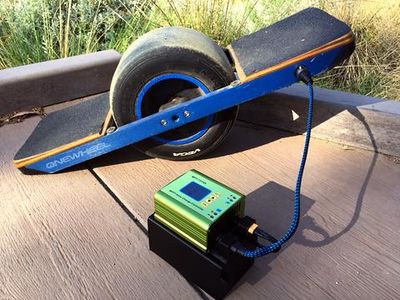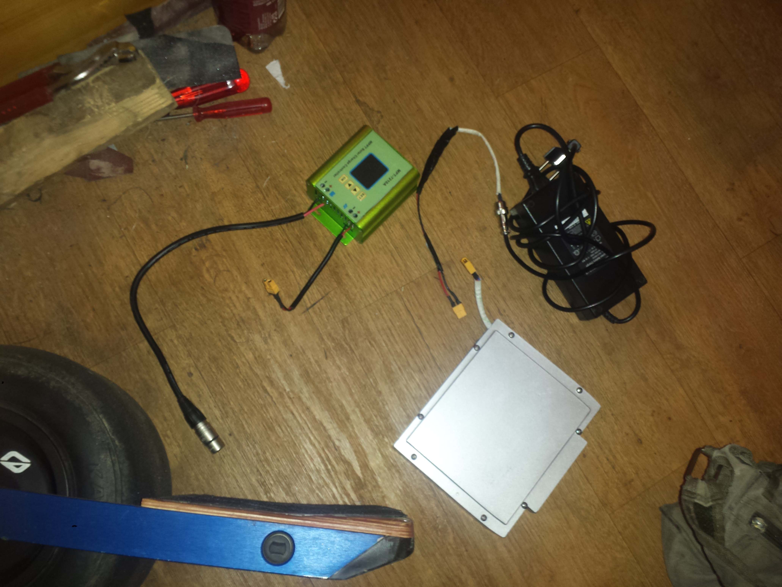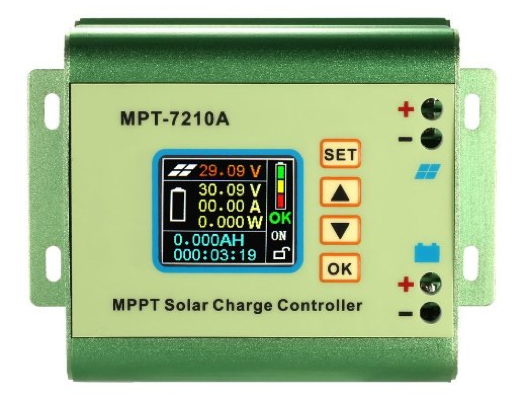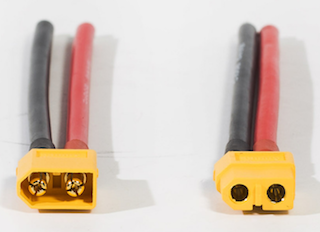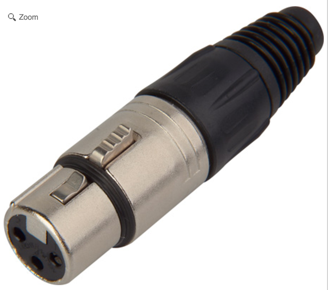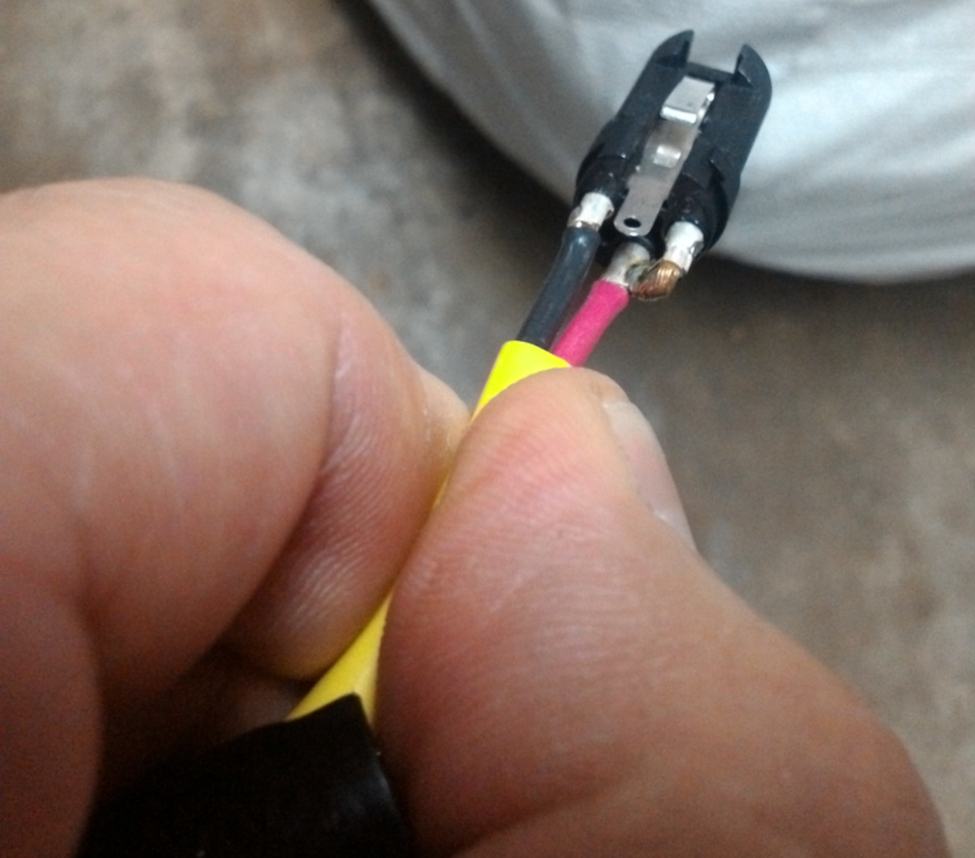Difference between revisions of "Charging on-the-go"
| (24 intermediate revisions by 6 users not shown) | |||
| Line 1: | Line 1: | ||
'''<pre style="color: red">Use at your own risk. I am not responsible if you break your Onewheel, injure yourself, someone else, or burn your house down.</pre>''' | '''<pre style="color: red">Use at your own risk. I am not responsible if you break your Onewheel, injure yourself, someone else, or burn your house down.</pre>''' | ||
== Overview of options == | == Overview of options == | ||
| Line 10: | Line 9: | ||
! Cons | ! Cons | ||
|- | |- | ||
| | | [[#DC battery pack|DC battery pack (e.g. solar charger)]] | ||
| | | | ||
- Lightest solution<br /> | |||
- Most energy efficient (DC->DC)<br /> | |||
- Lots of battery choices | |||
- Offers the greatest control over capacity and rate of charge | |||
| | | | ||
- The cheapest DIY solution is the most technical. Requires soldering.<br /> | |||
- Safety is dependent on batteries used | |||
- May require separate charger for portable pack depending on configuration | |||
|- | |- | ||
| [[#AC battery pack|AC battery pack (e.g. Chafon)]] | | [[#AC battery pack|AC battery pack (e.g. Chafon)]] | ||
| | | | ||
- Most common solution<br /> | |||
- Safe<br /> | |||
- Includes multiple USB ports and outlets | |||
| | | | ||
- Heavy (7lbs w/ battery and charger)<br /> | |||
- You must carry charger too<br /> | |||
- AC->DC is inefficient from energy perspective<br /> | |||
- Expensive ($300+)<br /> | |||
- Battery capacity readings are wildly inaccurate | |||
|- | |- | ||
| | | Car inverter | ||
| | | | ||
- Lots of options on the market<br /> | |||
- Don’t have to carry anything while riding<br /> | |||
- Safe | |||
| | | | ||
- Must be at your car to charge<br /> | |||
- Need to make sure it can handle 300W load | |||
|} | |} | ||
== Onewheel specs == | == Onewheel specs == | ||
| Line 46: | Line 50: | ||
* Wattage required to charge: 250-300W | * Wattage required to charge: 250-300W | ||
== Commercial Solutions == | |||
=== DC Battery Pack === | |||
[[File:Carvepower_Charger.jpg|frameless|400x400px]] | |||
DC Charger from Carvepower- https://carvepower.com/products/dc-charger-for-onewheel | |||
This charger uses a 36v 4.4ah hoverboard battery to charge the Onewheel. A solar charge controller boosts the output of the battery to the 58V 3.5A required by the Onewheel. One battery provides one charge, and the Onewheel wall charger is not necessary. A separate AC charger is provided to recharge the portable battery. The controller is attached to a mount which slides on to the battery case, making it easy to switch between multiple batteries. The total weight of the controller and one battery is 4lbs. | |||
The battery itself is not included in the kit, but can be purchased separately. Currently the best price available is from this EBay seller- http://www.ebay.com/itm/NEW-SAMSUNG-18650-36V-4-4AH-BATTERY-EBIKE-VAPE-POWERWALL-BATTERIES-20-CELLS-BMS-/201895735309?epid=1621923126&hash=item2f01ec700d:g:Mh8AAOSwSypY9Y7d | |||
Carvepower DC Charger instructions- https://www.dropbox.com/s/hkt86dyslpq5cyb/DC%20Charger%20Instructions.pdf?dl=0 | |||
== AC battery pack == | === AC battery pack === | ||
The idea is to use an AC battery pack with the standard Onewheel charger. | The idea is to use an AC battery pack with the standard [[Onewheel charger]]. | ||
[[File:Ac_inverter.png]] | [[File:Ac_inverter.png]] | ||
==== Tested solutions ==== | |||
{| class="wikitable" | {| class="wikitable" | ||
! Option | ! Option | ||
| Line 57: | Line 73: | ||
! Cons | ! Cons | ||
|- | |- | ||
| [http://amzn.to/2skjq8B Chafon CF-UPS008]<br/> | | [http://amzn.to/2skjq8B Chafon CF-UPS008]<br /> | ||
$290 for 2 charges (288Wh) | $290 for 2 charges (288Wh) | ||
| | | | ||
- Most common option in community | |||
| | | | ||
- Modified sine wave<br /> | |||
- Heavy - 7lbs | |||
|- | |- | ||
| | | | ||
[http://amzn.to/2sk9ITK igoeshopping]<br/> | [http://amzn.to/2sk9ITK igoeshopping]<br /> | ||
$311 for 2 charges (288Wh) | $311 for 2 charges (288Wh) | ||
| | | | ||
- Pure sine wave | |||
| | | | ||
- Heavy - 7lbs | |||
|- | |- | ||
| | | | ||
[http://amzn.to/2sxo0Rp AMSU]<br/> | [http://amzn.to/2sxo0Rp AMSU]<br /> | ||
$300 for 2.5 charges (330Wh) | $300 for 2.5 charges (330Wh) | ||
| | | | ||
- Pure sine wave | |||
| | | | ||
- Heavy - 7lbs | |||
|} | |} | ||
== DC battery pack == | ==== Incompatible with Onewheel ==== | ||
#ExpertPower Omega 453 | |||
== DIY DC battery pack == | |||
The idea is to use a solar charge controller to upconvert a portable battery’s voltage to the 58V that the Onewheel expects. The solar charge controller is typically used to charge a battery via a solar panel. However in this case, your portable battery takes place of the solar panel and your Onewheel is the battery you’re charging. | The idea is to use a solar charge controller to upconvert a portable battery’s voltage to the 58V that the Onewheel expects. The solar charge controller is typically used to charge a battery via a solar panel. However in this case, your portable battery takes place of the solar panel and your Onewheel is the battery you’re charging. | ||
| Line 89: | Line 108: | ||
Make sure you protect your battery with something soft in case you wipeout while riding. I suggest packing foam. | Make sure you protect your battery with something soft in case you wipeout while riding. I suggest packing foam. | ||
=== Step 1: choose a battery and charger === | === Step 1: choose a battery and charger === | ||
| Line 147: | Line 167: | ||
| | | | ||
# Less than one charge | # Less than one charge | ||
|- | |||
|Lipo Bricks (RC packs) | |||
(Good Value: [https://hobbyking.com/en_us/batteries/multistar-batteries.html?dir=desc&order=config MultiStar]) | |||
|$140 for 3 charges (444Wh) @ 2.6lbs | |||
| | |||
* Low cost | |||
* Offers fast charging of OW (0-100% under 20 min) | |||
* Can be recharged quickly with external charger | |||
* Packs are modular (Recommended configuration is two 6s packs with series connection for 12s (50V output) | |||
| | |||
* Requires occasional balancing | |||
* Packs are sometimes defective (low charging speed or dead cells) | |||
* Hobby-grade charger is recommended for balancing, cell health monitoring, and fast charging | |||
* Packs require protective case for safety, should be charged in a safe location etc. | |||
|} | |} | ||
You also need a way to charge your portable battery. | You also need a way to charge your portable battery. | ||
| Line 175: | Line 208: | ||
|} | |} | ||
To be safe, only charge when you’re near the charger and awake. | To be safe, buy a [http://amzn.to/2s2tXGy battery pouch] and only charge when you’re near the charger and awake. | ||
=== Step 2: buy the other parts === | === Step 2: buy the other parts === | ||
# [http://amzn.to/2thPS8I Solar charge controller] - $40 | # [http://amzn.to/2thPS8I Solar charge controller] - $40 | ||
[[File:charge_controller.png]] | |||
# [https://lunacycle.com/batteries/connectors/xt60-set-connectors-with-pigtails/ 2x XT60 pigtails] - $3 each | # [https://lunacycle.com/batteries/connectors/xt60-set-connectors-with-pigtails/ 2x XT60 pigtails] - $3 each | ||
[[File:xt60_pigtails.png]] | |||
# [http://www.markertek.com/product/nc3fx/neutrik-nc3fx-female-3-pin-xlr-connector-nickel-silver XLR plug] - $3 | # [http://www.markertek.com/product/nc3fx/neutrik-nc3fx-female-3-pin-xlr-connector-nickel-silver XLR plug] - $3 | ||
[[File:xlr_plug.png]] | |||
=== Step 3: configure the solar charge controller === | === Step 3: configure the solar charge controller === | ||
The output of the solar charge controller must match the output of the Onewheel charger. Your settings should look something like the photo below. | The output of the solar charge controller must match the output of the [[Onewheel charger]]. Your settings should look something like the photo below. | ||
[[File:controller_config.png]] | |||
The critical | The first line is for monitoring your supply battery, it is not critical if this is incorrect. Set the first line (where it says 32.5V) to the minimum voltage of your battery. 32V is generally a safe setting for a 36V-rated battery. | ||
The critical settings are on the second and third lines (Target voltage ('''58V''') and Amp limit). If the voltage is set incorrectly, the battery will overcharge or may not fully charge. | |||
The stock charger supplies 3.5A. If you are using a 36V battery, you will not be able to exceed 3.5A. If your supply voltage is 50-60V, you will be able to charge the OW at a higher rate. Limited testing has been done on fast-charging, but there do not appear to be any major drawbacks (cycle life and warranty may be affected). | |||
Remember! The battery pack should be on the solar panel label and OW on the battery label on the solar charge controller. | |||
'''Never charge your batteries while they are cold!!!''' | |||
The MPT-7210A manual can be found [http://www.yampe.com/images/pdf/2907.pdf here]. READ IT COMPLETELY BEFORE USING[[File:Fast charge.jpg|thumb|371x371px|Lipo Pack 12S running at 8A|none]] | |||
The manual can be found [http://www. | |||
=== Step 4: solder the wires to the XLR plug === | === Step 4: solder the wires to the XLR plug === | ||
| Line 199: | Line 241: | ||
Below is the correct configuration. Notice the positive wire is connected to *both* pins 2 and 3 of the XLR plug. If you want to verify this yourself, you can easily open the Onewheel charger’s XLR plug. | Below is the correct configuration. Notice the positive wire is connected to *both* pins 2 and 3 of the XLR plug. If you want to verify this yourself, you can easily open the Onewheel charger’s XLR plug. | ||
[[File:xlr_solder.png]] | |||
Latest revision as of 18:05, 18 February 2018
Use at your own risk. I am not responsible if you break your Onewheel, injure yourself, someone else, or burn your house down.
Overview of options
You have to choose what’s most important to you. Every option has tradeoffs on price, weight, capacity, and safety.
| Option | Pros | Cons |
|---|---|---|
| DC battery pack (e.g. solar charger) |
- Lightest solution - Offers the greatest control over capacity and rate of charge |
- The cheapest DIY solution is the most technical. Requires soldering. - May require separate charger for portable pack depending on configuration |
| AC battery pack (e.g. Chafon) |
- Most common solution |
- Heavy (7lbs w/ battery and charger) |
| Car inverter |
- Lots of options on the market |
- Must be at your car to charge |
Onewheel specs
- Charger output: 58V 3.5A
- Charger capacity: 130Wh
- Wattage required to charge: 250-300W
Commercial Solutions
DC Battery Pack
DC Charger from Carvepower- https://carvepower.com/products/dc-charger-for-onewheel
This charger uses a 36v 4.4ah hoverboard battery to charge the Onewheel. A solar charge controller boosts the output of the battery to the 58V 3.5A required by the Onewheel. One battery provides one charge, and the Onewheel wall charger is not necessary. A separate AC charger is provided to recharge the portable battery. The controller is attached to a mount which slides on to the battery case, making it easy to switch between multiple batteries. The total weight of the controller and one battery is 4lbs.
The battery itself is not included in the kit, but can be purchased separately. Currently the best price available is from this EBay seller- http://www.ebay.com/itm/NEW-SAMSUNG-18650-36V-4-4AH-BATTERY-EBIKE-VAPE-POWERWALL-BATTERIES-20-CELLS-BMS-/201895735309?epid=1621923126&hash=item2f01ec700d:g:Mh8AAOSwSypY9Y7d
Carvepower DC Charger instructions- https://www.dropbox.com/s/hkt86dyslpq5cyb/DC%20Charger%20Instructions.pdf?dl=0
AC battery pack
The idea is to use an AC battery pack with the standard Onewheel charger.
Tested solutions
| Option | Pros | Cons |
|---|---|---|
| Chafon CF-UPS008 $290 for 2 charges (288Wh) |
- Most common option in community |
- Modified sine wave |
|
igoeshopping |
- Pure sine wave |
- Heavy - 7lbs |
|
AMSU |
- Pure sine wave |
- Heavy - 7lbs |
Incompatible with Onewheel
- ExpertPower Omega 453
DIY DC battery pack
The idea is to use a solar charge controller to upconvert a portable battery’s voltage to the 58V that the Onewheel expects. The solar charge controller is typically used to charge a battery via a solar panel. However in this case, your portable battery takes place of the solar panel and your Onewheel is the battery you’re charging.
Make sure you protect your battery with something soft in case you wipeout while riding. I suggest packing foam.
Step 1: choose a battery and charger
| Battery options | Specs | Pros | Cons |
|---|---|---|---|
| 36V 12.5Ah Lithium Scooter battery | $209 for 3.5 charges (450Wh) @ 5lbs |
|
|
| 36V 4.4ah Lithium batteries from eBay | $60 for ~1 charge (158Wh) |
|
|
| LiFePO4 | $35 for ½ charge (42Wh?) @ 1lb |
|
|
| 52V Mighty Mini | $230 for 2.5 charges (300Wh) @ 3.3lb |
|
|
| Lithium battery from Jet.com | $129 for ~1 charge (158Wh) @ 2.6lbs |
|
|
| 36V LiGo | $150 for <1 charge (98Wh) @ 1.3lbs |
|
|
| Lipo Bricks (RC packs)
(Good Value: MultiStar) |
$140 for 3 charges (444Wh) @ 2.6lbs |
|
|
You also need a way to charge your portable battery.
| Charger options | Pros | Cons |
|---|---|---|
| LunaCycle charger |
|
|
| AC → DC charger |
|
|
| LiFePO4 charger |
|
To be safe, buy a battery pouch and only charge when you’re near the charger and awake.
Step 2: buy the other parts
- Solar charge controller - $40
- 2x XT60 pigtails - $3 each
- XLR plug - $3
Step 3: configure the solar charge controller
The output of the solar charge controller must match the output of the Onewheel charger. Your settings should look something like the photo below.
The first line is for monitoring your supply battery, it is not critical if this is incorrect. Set the first line (where it says 32.5V) to the minimum voltage of your battery. 32V is generally a safe setting for a 36V-rated battery.
The critical settings are on the second and third lines (Target voltage (58V) and Amp limit). If the voltage is set incorrectly, the battery will overcharge or may not fully charge.
The stock charger supplies 3.5A. If you are using a 36V battery, you will not be able to exceed 3.5A. If your supply voltage is 50-60V, you will be able to charge the OW at a higher rate. Limited testing has been done on fast-charging, but there do not appear to be any major drawbacks (cycle life and warranty may be affected).
Remember! The battery pack should be on the solar panel label and OW on the battery label on the solar charge controller.
Never charge your batteries while they are cold!!!
The MPT-7210A manual can be found here. READ IT COMPLETELY BEFORE USING
Step 4: solder the wires to the XLR plug
The Onewheel’s XLR plug requires a different wiring than the off-the-shelf XLR plugs. Unfortunately, that means you have to do some soldering.
Below is the correct configuration. Notice the positive wire is connected to *both* pins 2 and 3 of the XLR plug. If you want to verify this yourself, you can easily open the Onewheel charger’s XLR plug.
Step 5: hook it all up!
Portable battery → male XT60 pigtail → solar charge converter → female XT60 pigtail → male XT60 pigtail → soldered XLR plug → (wait until voltage reaches 58V before plugging in!) Onewheel
Sometimes the OW does not go into its charge mode automatically. Simply press the power button in this case.
When you’re done charging, I suggest turning off the solar charge converter first before unplugging anything. Then disconnect the battery. Then unplug from Onewheel.
Charging Onewheel to 100% is safe. You’ll see the amps ramp down on the solar charge converter display as you enter “trickle charge” mode. But you’ll want to disconnect soon or it’ll just slowly drain your battery.

